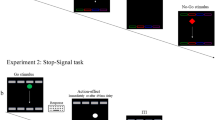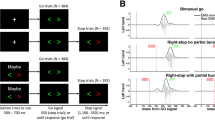Abstract
It is solidly established that unequal stimulus frequencies lead to faster responses to the more likely stimulus; however, the effect of this probability bias on response inhibition is still debated. To tackle this issue, we administered two versions of the stop-signal task to 18 right-handed healthy subjects. In one version, we manipulated the frequency of right and left targets appearance when subjects were required to produce speeded responses (no-stop trials) with the right arm, whereas stop signals occurred with equal frequencies after right or left targets (no-stop signal bias). In the other version, we manipulated the frequency of appearance of stop signals after right or left targets, whereas no-stop trials toward right or left targets had the same frequency (stop-signal bias). Surprisingly, we found a very modest, if any, increase in response readiness toward the more frequent stimulus. However, the no-stop signal bias had an effect on the speed of inhibitory control, as subjects were always faster to suppress a movement toward the side where targets were less likely to occur. Differently, the stop-signal bias had a much more powerful effect. In fact, subjects were faster to withhold movements toward the side where targets were more frequent, while they exhibited longer reaction times for reaches toward the more likely targets. Overall, these results suggest that action preparation and action inhibition are independent competing processes, but subjects tend to place automatically greater importance on the stop task.





Similar content being viewed by others
References
Band GP, van der Molen MW, Logan GD (2003) Horse-race model simulations of the stop-signal procedure. Acta Psychol (Amst) 112:105–142
Boucher L, Palmieri TJ, Logan GD, Schall JD (2007) Inhibitory control in mind and brain: an interactive race model of countermanding saccades. Psychol Rev 114:376–397
Bryden MP (1977) Measuring handedness with questionnaires. Neuropsychologia 15:617–624
Cavina-Pratesi C, Bricolo E, Pellegrini B, Marzi CA (2004) At what stage of manual visual reaction time does interhemispheric transmission occur: controlled or ballistic? Exp Brain Res 155:220–230
Chikazoe J, Jimura K, Hirose S, Yamashita K, Miyashita Y, Konishi S (2009) Preparation to inhibit a response complements response inhibition during performance of a stop-signal task. J Neurosci 29:15870–15877
Colonius H (1990) A note on the stop-signal paradigm, or how to observe the unobservable. Psychol Rev 97:309–312
Eickhoff SB, Pomjanski W, Jakobs O, Zilles K, Langner R (2011) Neural correlates of developing and adapting behavioral biases in speeded choice reactions: an FMRI study on predictive motor coding. Cereb Cortex 21:1178–1191
Jahfari S, Stinear CM, Claffey M, Verbruggen F, Aron AR (2010) Responding with restraint: what are the neurocognitive mechanisms? J Cogn Neurosci 22:1479–1492
Jahfari S, Verbruggen F, Frank MJ, Waldorp LJ, Colzato L, Ridderinkhof KR, Forstmann BU (2012) How preparation changes the need for top–down control of the basal ganglia when inhibiting premature actions. J Neurosci 32:10870–10878
Laming DJR (1969) Subjective probability in choice-reaction experiments. J Math Psychol 6:80–121
Lansbergen MM, Schutter DJ, Kenemans JL (2007) Subject impulsivity and baseline EEG in relation to stopping performance. Brain Res 1148:161–169
Levitt H (1971) Transformed up–down methods in psychoacoustics. J Acoust Soc Am 49:467–477
Li CS, Krystal JH, Mathalon DH (2005) Fore-period effect and stop-signal reaction time. Exp Brain Res 167:305–309
Logan GD (1994) On the ability to inhibit thought and action: a users’ guide to the stop signal paradigm. In: Dagenbach D, Carr TH (eds) Inhibitory processes in attention, memory, and language. Academic Press, San Diego, pp 189–239
Logan GD, Burkell J (1986) Dependence and independence in responding to double stimulation: a comparison of stop, change, and dual-task paradigms. J Exp Psychol Hum Percept Perform 12:549–563
Logan GD, Cowan WB (1984) On the ability to inhibit thought and action: a theory of an act of control. Psychol Rev 91:295–327
Lungu OV, Wächter T, Liu T, Willingham DT, Ashe J (2004) Probability detection mechanisms and motor learning. Exp Brain Res 159:135–150
Marzi CA, Bisiacchi P, Nicoletti R (1991) Is interhemispheric transfer of visuomotor information asymmetric? Evidence from a meta-analysis. Neuropsychologia 29:1163–1177
Mattia M, Spadacenta S, Pavone L, Quarato P, Esposito V, Sparano A, Sebastiano F, Di Gennaro G, Morace R, Cantore G, Mirabella G (2012) Stop-event-related potentials from intracranial electrodes reveal a key role of premotor and motor cortices in stopping ongoing movements. Front Neuroeng 5:12
Miller J (1998) Effects of stimulus-response probability on choice reaction time: evidence from the lateralized readiness potential. J Exp Psychol Hum Percept Perform 24:1521–1534
Mirabella G, Pani P, Parè M, Ferraina S (2006) Inhibitory control of reaching movements in humans. Exp Brain Res 174:240–255
Mirabella G, Pani P, Ferraina S (2008) Context influence on the preparation and execution of reaching movements. Cog Neuropsychol 25:996–1010
Mirabella G, Pani P, Ferraina S (2009) The presence of visual gap affects the duration of stopping process. Exp Brain Res 192:199–209
Mirabella G, Iaconelli S, Romanelli P, Modugno N, Lena F, Manfredi M, Cantore G (2012) Deep brain stimulation of subthalamic nuclei affects arm response inhibition in Parkinson’s patients. Cereb Cortex 22:1124–1132
Mirabella G, Iaconelli S, Modugno N, Giannini G, Lena F, Cantore G (2013) Stimulation of subthalamic nuclei restores a near normal planning strategy in Parkinson’s patients. PLoS ONE 8:e62793
Montagnini A, Chelazzi L (2009) Dynamic interaction between “go” and “stop” signals in the saccadic eye movement system: new evidence against the functional independence of the underlying neural mechanisms. Vis Res 49:1316–1328
Osman A, Kornblum S, Meyer DE (1986) The point of no return in choice reaction time: controlled and ballistic stages of response preparation. J Exp Psychol Hum Percept Perform 12:243–258
Osman A, Kornblum S, Meyer DE (1990) Does motor programming necessitate response execution? J Exp Psychol Hum Percept Perform 16:183–198
Ramautar JR, Kok A, Ridderinkhof KR (2004) Effects of stop-signal probability in the stop-signal paradigm: the N2/P3 complex further validated. Brain Cogn 56:234–252
Stevenson SA, Elsley JK, Corneil BD (2009) A “gap effect” on stop signal reaction times in a human saccadic countermanding task. J Neurophysiol 101:580–590
Swann NC, Cai W, Conner CR, Pieters TA, Claffey MP, George JS, Aron AR, Tandon N (2012) Roles for the pre-supplementary motor area and the right inferior frontal gyrus in stopping action: electrophysiological responses and functional and structural connectivity. Neuroimage 59:2860–2870
van den Wildenberg WP, van der Molen MW, Logan GD (2002) Reduced response readiness delays stop signal inhibition. Acta Psychol (Amst) 111:155–169
van den Wildenberg WP, van Boxtel GJ, van der Molen MW (2003) The duration of response inhibition in the stop-signal paradigm varies with response force. Acta Psychol (Amst) 114:115–129
Velay JL, Benoit-Dubrocard S (1999) Hemispheric asymmetry and interhemispheric transfer in reaching programming. Neuropsychologia 37:895–903
Verbruggen F, Logan GD (2009) Proactive adjustments of response strategies in the stop-signal paradigm. J Exp Psychol Hum Percept Perform 35:835–854
Zandbelt BB, Vink M (2010) On the role of the striatum in response inhibition. PLoS ONE 5:e13848
Zandbelt BB, Bloemendaal M, Neggers SFW, Kahn RS, Vink M (2012) Expectations and violations: delineating the neural network of proactive inhibitory control. Hum Brain Mapp. doi:10.1002/hbm.22047
Acknowledgments
We would like to thank very much Leonardo Chelazzi and Anna Montagni for valuable advice concerning experimental procedures. We also thank Bram Zandbelt and two anonymous reviewers for extremely useful comments on the manuscript. This research was supported by the Italian Ministry of Work, Health and Social Policies (Bando Giovani Ricercatori 2007 to GM) and by the Italian Ministry of University and Research (PRIN n.2008_RBFNLH_005 to GM).
Conflict of interest
The authors declare that no competing interests exist.
Author information
Authors and Affiliations
Corresponding author
Rights and permissions
About this article
Cite this article
Federico, P., Mirabella, G. Effects of probability bias in response readiness and response inhibition on reaching movements. Exp Brain Res 232, 1293–1307 (2014). https://doi.org/10.1007/s00221-014-3846-8
Received:
Accepted:
Published:
Issue Date:
DOI: https://doi.org/10.1007/s00221-014-3846-8




